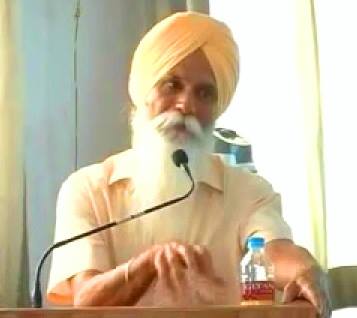Gail Omvedt
“Dalit”, “Scheduled Caste”, “Ex-Untouchable” and “Harijan”. These are only some of the many words used to refer to the most oppressed sections of Indian society, “untouchable” in the traditional caste order, performers of the most degrading task, and still today caught in the throes of poverty, discrimination and the remnants of untouchability.
“Dalit” is still probably the most widespread of these terms, but it is not uncontested. Many are uncomfortable with its apparent militancy. It means literally “crushed” or “ground down”, and it has an interesting history. It is first found, apparently, in the ’30s, when it was used as a Marathi and Hindi translation for the British term “Depressed Classes.” (As elsewhere, “classes” here meant “castes”, something to remember when we are discussing OBCs.) Ambedkar used it in this way to refer to his Depressed Class conferences, though in English we most often find him using the simple and descriptive term “Untouchable”. His conflicts with Gandhi in the early ’30s were at least partly a matter of terminology. Gandhi had, for him, the brilliant idea of using the term “Harijan”, taken from the bhakti movement. Ambedkar resisted this, just as he resisted Gandhi’s attempt to turn an Untouchable League (which Ambedkar thought should take up general issues of civil rights) into a paternalistic organisation controlled by upper-caste Hindus. Ambedkar, and militant Dalits ever since, have seen the word “Harijan” as demeaning and false, hence oppressive.
Then, in the early ’70s, “Dalit” became a symbol of the new militant movement of the oppressed, with the formation of the Dalit Panthers in Maharashtra, the Dalit Sangharsh Samiti in Karnataka, and many others. These groups became involved in struggles against atrocities, sometimes in open and violent clashes with caste Hindus. The word echoed in numerous slum and village-based groups that emerged during that period. Its militancy, its open proclamation of oppression, attracted youth restless under the scorn of the so-called “upper” castes, ready to fight. It became generalised, and used even in newspaper reports. It is, after all, a more colourful expression than the cold and official sounding “Scheduled Caste”. And, the Dalit Panther manifesto proclaimed that “Dalit” meant “all oppressed”, including workers and poor peasants. It seemed a fitting term for the new era of assertion of the various “new social movements” of the ’70s and ’80s.
Yet the use of “Dalit” has not gone uncontested. For one, Kanshi Ram rejected it when he formed his Bahujan Samaj Party, though he earlier had used it with DS-4, the Dalit Shoshit Samaj Sangh, as a militant organisation. For his political party, however, he wanted to formulate a wider appeal, and though the Dalit Panthers had given a broad meaning to the term, still it had come to be used in practice only for the Scheduled Castes. “Bahujan”, meaning literally “majority” (and with some echoes from Buddhism, bahujan hitaya, bahujan sukaya), was meant to be used for SCs, STs, OBCs and minorities. Thus, in all his various disputes with other parties (in particular the Republican Parties based mainly in Maharashtra), Kanshi Ram insisted that his was not in fact only a “Dalit” party.
Some of the more militant Buddhists don’t like the term. Yashwant Manohar, a writer from Maharashtra, said once, “Call me Buddhist, call me Mahar, call me Naga, anything but Dalit!” It was its negative connotations that were rejected. Many of these Dalits wanted a broader, more positive identity, that moved beyond tradition; for this reason some have adopted the term “Buddhist” in preference to any word implying a caste identification.
Today, in addition, with many disputes arising among the various castes of ex-Untouchables, and with the formerly “weaker” SCs asserting themselves in new ways, it seems clear that an all-embracing “Dalit” identity is being rejected by many. The pendulum seems to be swinging back to a caste identification. The conflict between the Malas and Madigas in Andhra is only the most stark example, but similar tensions are seen in north India, between the large and powerful Chamar group and slightly smaller (but still very widespread) castes such as the Valmikis, and in Maharashtra between Mahars and Matangas. In Tamil Nadu, the former Pallars began asserting themselves as DKVs, “Devendra Kula Vellalars”. “Is Dalit unity possible?” has become an important question and it is quite likely that most of the former Untouchables would simply identify themselves by their caste names.
It is difficult to predict the future, but “Harijan” definitely seems to be out for the conscious and assertive youth, while the ambiguity about caste identities and an all-embracing “Dalit” identity remains. “Dalit” remains the most useful inclusive term and — strikingly — in some ways the least controversial.
Changing terminology should surprise no one. In the US, the oppressed group once known as “Negroes” or “Coloured People” (remember the National Association for the Advancement of Coloured People, founded by none other than the militant W.E.B. Du Bois) moved to a preference for “Black” in the ’60s and ’70s, to the less colour-conscious, more ethnic oriented “African-American” today. Mobile social groups, finally, chose their own identities, and that is what the former Untouchables, the Dalits, the oppressed sections of India, will do.
[Courtesy: The Indian Express, July 22, 2008]








